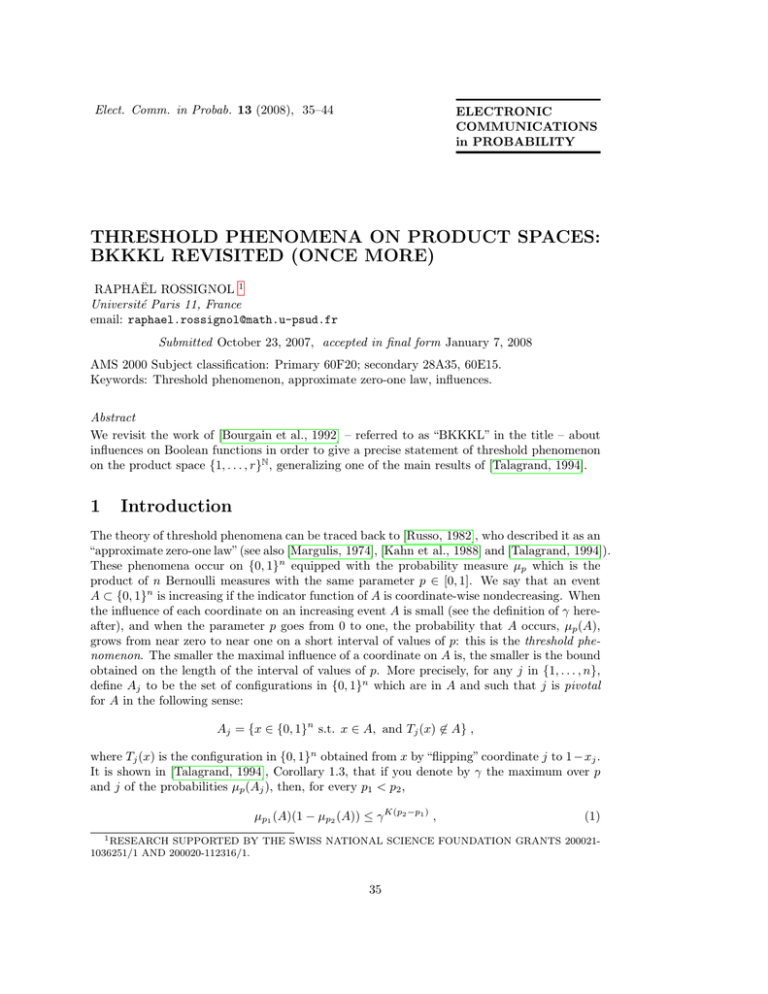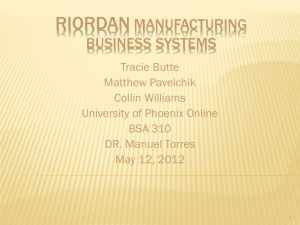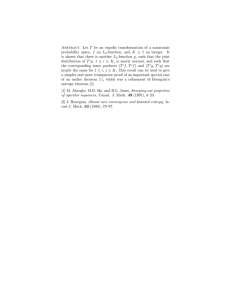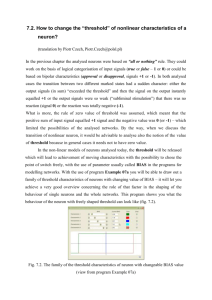THRESHOLD PHENOMENA ON PRODUCT SPACES: BKKKL REVISITED (ONCE MORE)
advertisement

Elect. Comm. in Probab. 13 (2008), 35–44
ELECTRONIC
COMMUNICATIONS
in PROBABILITY
THRESHOLD PHENOMENA ON PRODUCT SPACES:
BKKKL REVISITED (ONCE MORE)
RAPHAËL ROSSIGNOL 1
Université Paris 11, France
email: raphael.rossignol@math.u-psud.fr
Submitted October 23, 2007, accepted in final form January 7, 2008
AMS 2000 Subject classification: Primary 60F20; secondary 28A35, 60E15.
Keywords: Threshold phenomenon, approximate zero-one law, influences.
Abstract
We revisit the work of [Bourgain et al., 1992] – referred to as “BKKKL” in the title – about
influences on Boolean functions in order to give a precise statement of threshold phenomenon
on the product space {1, . . . , r}N , generalizing one of the main results of [Talagrand, 1994].
1
Introduction
The theory of threshold phenomena can be traced back to [Russo, 1982], who described it as an
“approximate zero-one law”(see also [Margulis, 1974], [Kahn et al., 1988] and [Talagrand, 1994]).
These phenomena occur on {0, 1}n equipped with the probability measure µp which is the
product of n Bernoulli measures with the same parameter p ∈ [0, 1]. We say that an event
A ⊂ {0, 1}n is increasing if the indicator function of A is coordinate-wise nondecreasing. When
the influence of each coordinate on an increasing event A is small (see the definition of γ hereafter), and when the parameter p goes from 0 to one, the probability that A occurs, µp (A),
grows from near zero to near one on a short interval of values of p: this is the threshold phenomenon. The smaller the maximal influence of a coordinate on A is, the smaller is the bound
obtained on the length of the interval of values of p. More precisely, for any j in {1, . . . , n},
define Aj to be the set of configurations in {0, 1}n which are in A and such that j is pivotal
for A in the following sense:
Aj = {x ∈ {0, 1}n s.t. x ∈ A, and Tj (x) 6∈ A} ,
where Tj (x) is the configuration in {0, 1}n obtained from x by “flipping” coordinate j to 1 − xj .
It is shown in [Talagrand, 1994], Corollary 1.3, that if you denote by γ the maximum over p
and j of the probabilities µp (Aj ), then, for every p1 < p2 ,
µp1 (A)(1 − µp2 (A)) ≤ γ K(p2 −p1 ) ,
(1)
1 RESEARCH SUPPORTED BY THE SWISS NATIONAL SCIENCE FOUNDATION GRANTS 2000211036251/1 AND 200020-112316/1.
35
36
Electronic Communications in Probability
where K is a universal constant. This result was also derived independently by [Friedgut and Kalai, 1996],
and both results were built upon an earlier paper by [Kahn et al., 1988], where one can
find an important breakthrough with the use of Bonami-Beckner’s hypercontractivity estimates. A much simpler proof, giving the best constants up to now, was obtained later by
[Falik and Samorodnitsky, 2007], and their result will be one of the main tool that we shall
use in this paper. See also [Rossignol, 2006] for a more complete description of threshold
phenomena, and [Friedgut, 2004, Hatami, 2006] for related questions when the event A is not
monotone.
This kind of phenomenon is interesting in itself, but has also been proved useful as a theoretical
tool, notably in percolation (see [Bollobás and Riordan, 2006c, Bollobás and Riordan, 2006b,
Bollobás and Riordan, 2006a, van den Berg, 2007]). It seems to be partly folklore that this
phenomenon occurs on other product spaces than {0, 1}n . Notably, Theorem 5 in [Bollobás and Riordan, 2006a]
gives a threshold result for symmetric functions on {1, 2, 3}n with an extremely short proof,
mainly pointing to [Friedgut and Kalai, 1996]. A strongly related result is [Bourgain et al., 1992],
where it is proved that for any subset A of a product probability space of dimension n, there
is one coordinate that has influence of order at least log n/n on A. Although the result in
[Bourgain et al., 1992] is stated in terms of influences and not in terms of threshold phenomena, the proof can be rephrased and slightly adapted to show that threshold phenomena occur
on various product spaces.
Being asked by Rob van den Berg for a reference on generalizations of (1) to {1, . . . , r}N , we
could not find a truly satisfying one. The work of [Paroissin and Ycart, 2003] is close in spirit
to what we were looking for, but is stated only for symmetric sets in finite dimension. Also,
Theorem 3.4 in [Friedgut and Kalai, 1996] is even closer to what we need but is not quite
adapted to {1, . . . , r}N since the quantity γ = maxj µp (Aj ) is replaced by the maximum of all
influences, which is worse than the equivalent of γ in {1, . . . , r}N . The purpose of the present
note is to provide an explicit statement of the threshold phenomenon on {1, . . . , r}N , with a
rigorous, detailed proof. We insist strongly on the fact that the spirit of what is written in
this note can be seen as already present in [Bourgain et al., 1992], [Friedgut and Kalai, 1996]
and [Talagrand, 1994].
Our goal will be accomplished in two steps. The first one, presented in section 2, is a general
functional inequality on the countable product [0, 1]N equipped with its Lebesgue measure.
Then, in section 3, we present the translation of this result into a threshold phenomenon on
{1, . . . , r}N . This is the main result of this note, stated in Corollary 3.1.
2
A functional inequality on [0, 1]N , following [Bourgain et al., 1992]
In [Talagrand, 1994], inequality (1) is derived from a functional inequality on ({0, 1}n , µp )
(Theorem 1.5 in [Talagrand, 1994]). Falik and Samorodnitsky’s main result is also a functional
inequality on ({0, 1}n , µp ), with a slightly different flavour but the same spirit: it improves
upon the classical Poincaré inequality essentially when the discrete partial derivatives of the
function at hand have low L1 -norm with respect to their L2 -norm. Such inequalities have
been extended to some continuous settings in [Benaim and Rossignol, 2006], where they were
called “modified Poincaré inequalities”. The discrete partial derivative is then replaced by a
semi-group which is required to satisfy a certain hypercontractivity property.
In this section, we take a different road to generalize the modified Poincaré inequality of
Talagrand (Theorem 1.5 in [Talagrand, 1994]). This is done by combining the approach of
[Bourgain et al., 1992] and [Falik and Samorodnitsky, 2007]. This is also very close in spirit
Threshold phenomena on product spaces
37
to what is done in [Friedgut, 2004]. We will obtain a functional inequality on [0, 1]N equipped
with the Lebesgue measure, which can be seen as a modified Poincaré inequality. All measures
considered in this section are Lebesgue measures on Lebesgue measurable sets.
First, we need some notations. Let (xi,j ) i≥1 be independent symmetric Bernoulli random
j≥0
P
x
variables. For each j, the random variable i≥1 2i,j
is uniformly distributed on [0, 1], whereas
i
Pm xi,j
k
is
uniformly
distributed
on
{
;
k
=
0,
.
.
.
, 2m − 1}. For positive integers m and n,
i=1 2i
2m
m,n
N
define a random variable X
with values in [0, 1] as follows:
Pm xi,j
if j ≤ n
i=1 2i
(X m,n )j =
xi,j
P
if j > n
i≥1 2i
For any real function f on [0, 1]N , we define the following random variables:
m,n
∆m,n
) − Exi,j [f (X m,n )] ,
i,j f = f (X
where Exi,j denotes the expectation with respect to xi,j only. Define λ to be the Lebesgue
measure on [0, 1], and if f belongs to L2 ([0, 1]N , λ⊗N ), denote by V arλ (f ) the variance of f
with respect to λ⊗N .
Finally, define, for any positive integer n and any real numbers y1 , . . . , yn :
Z
O
fn (y0 , . . . , yn ) = f (y0 , . . . , yn , yn+1 , . . .)
dλ(yk ) .
k≥n+1
We shall use the following hypothesis on f :
For every integer n, fn is Riemann-integrable.
(2)
The following result can be seen as a generalization of Theorem 1.5 in [Talagrand, 1994].
Theorem 2.1. Let f be a real measurable function on [0, 1]N . Define, for p ≥ 0:
Np (f ) = lim sup lim sup
n→∞
m→∞
m
n X
X
2
p p
E(|∆m,n
i,j f | ) .
j=0 i=1
Suppose that f belongs to L2 ([0, 1]N ), and satisfies hypothesis (2). Then,
N2 (f ) ≥
V arλ (f )
1
V arλ (f ) log
.
2
N1 (f )
Proof : Denote by Y m,n the first n coordinates of X m,n . Theorem 2.2 in [Falik and Samorodnitsky, 2007]
implies that:
m
n X
X
j=0 i=1
2
E(∆m,n
i,j f ) ≥
1
V ar(fn (Y m,n ))
.
V ar(fn (Y m,n )) log Pn Pm
m,n
2
2
j=0
i=1 E(|∆i,j f |)
Notice that E(fn (Y m,n )) is a Riemann-sum of fn over [0, 1]n . Since fn is Riemann-integrable,
V ar(fn (Y m,n )) converges to V ar(fn (U0 , . . . , Un )) when m goes to infinity, where U0 , . . . , Un
are independent random variables with uniform distribution on [0, 1]. Then, this is for instance
38
Electronic Communications in Probability
a consequence of Doob’s convergence theorems for martingales bounded in L2 , fn (U1 , . . . , Un )
converges in L2 to f as n tends to infinity. Thus,
lim lim V ar(fn (Y m,n )) = V arλ (f ) .
n→∞ m→∞
The theorem follows.
¤
If a function f is coordinate-wise nondecreasing, we shall say it is increasing. Now, we can
get a simplified version of Theorem 2.1 for increasing functions. To this end, let us define the
random variable X ∞ with values in [0, 1]N as follows:
X xi,j
∀j ≥ 0, (X ∞ )j =
,
2i
i≥1
and let:
∞
∞
∆∞
i,j f = f (X ) − Exi,j [f (X )] .
Corollary 2.2. Let f be a real measurable function on [0, 1]N , increasing for the coordinatewise partial order. Define, for p ≥ 0:
Mp (f ) =
∞
∞ X
X
2
p p
E(|∆∞
i,j f | ) .
j=0 i=1
Then,
M2 (f ) ≥
V arλ (f )
1
V arλ (f ) log
.
2
M1 (f )
Proof : We only need to show that f satisfies the hypotheses of Theorem 2.1, and that Np (f ) ≤
Mp (f ), at least when p equals 1 and 2. Since f is coordinate-wise increasing, so is fn for every
n, and thus hypothesis (2) is satisfied. The function f is trivially in L2 ([0, 1]N , λ⊗N ) since it
is a real measurable increasing function on [0, 1]N , and therefore is bounded. We shall use the
following notation: for ε ∈ {0, 1}, f (X m,n |xi,j = ε) denotes the value of f at X m,n where the
value of xi,j is forced to be ε, and for t ∈ [0, 1], f (X m,n |yj = t) denotes the value of f at X m,n
where the value of (X m,n )j is replaced by t. We also use the notation E(xi′ ,j )i′ <i (g(X m,n )) to
denote the expectation with respect to the random variables (xi′ ,j )i′ <i . For j ≤ n, and p ≥ 1,
1
E(xi′ ,j )i′ <i (|f (X m,n |xi,j = 1) − f (X m,n |xi,j = 0)|p ) ,
(3)
2p
¯ Ã
¯
!
i−1
¯
X xi′ ,j
X
X
1
1
1 ¯¯
εi′
m,n ¯
=
+
f
X
y
=
¯
¯ j
′ +
p
i−1
i
i
¯
¯
2
2
2
2
2i′
i′ >i
i′ =1
ε∈{0,1}i−1
¯
Ã
!¯p
i−1
¯
X
εi′ X xi′ ,j ¯¯
m,n ¯
+
−f X
¯ ,
¯y j =
¯
2i′
2i′ ¯
i′ >i
i′ =1
¯ Ã
¯
!
2i−1
¯
X xi′ ,j
X−1 ¯¯
1
1
k
m,n ¯
=
¯f X
¯yj = i−1 + i +
¯
¯
2p+i−1
2
2
2i′
i′ >i
k=0
¯
!¯p
Ã
¯
X xi′ ,j ¯¯
k
m,n ¯
−f X
¯ ,
¯yj = i−1 +
¯
2
2i′ ¯
′
p
E(xi′ ,j )i′ ≤i (|∆m,n
i,j f | ) =
i >i
Threshold phenomena on product spaces
Let us define tk =
k
2i
+
p
E(xi′ ,j )i′ ≤i (|∆m,n
i,j f | )
xi′ ,j
i′ >i 2i′ .
P
Notice that tk < tk+1 . Then,
1
=
39
2p+i−1
2i−1
X−1
|f (X m,n |yj = t2k+1 ) − f (X m,n |yj = t2k )|p ,
k=0
i−1
2
−1
(2kf k∞ )p−1 X
|f (X m,n |yj = t2k+1 ) − f (X m,n |yj = t2k )| ,
2p+i−1
≤
k=0
kf kp∞
,
2i−1
≤
p
2
since f is increasing. Thus, when n and j are fixed, (E(|∆m,n
i,j f | 1Ii≤m ) )i≥1 is dominated
2−2i
2p
by (2
kf k∞ )i≥1 , whose sum converges. On the other hand, since f is coordinate-wise
increasing, the function yj 7→ f ((yi )i≥1 ) is Riemann-integrable for any fixed (yi )i6=j and any
j. Thus,
p
∞ p
lim E(|∆m,n
i,j f | ) = E(|∆i,j f | ) .
m∞
Therefore, by Lebesgue’s dominated convergence theorem,
lim
m∞
m
X
2
p p
E(|∆m,n
i,j f | )
i=1
=
∞
X
2
p p
E(|∆∞
i,j f | ) ,
i=1
which implies Np (f ) = Mp (f ). The result follows from Theorem 2.1.
3
¤
Threshold phenomenon on {1, . . . , r}N
Let r be a positive integer. Let I =]a, b[ be a connected open subset of R with a < b, and for
every t in I, let µt be a probability measure on {1, . . . , r}, νt,n be the product measure µ⊗n
on
t
on HN = {1, . . . , r}N . We suppose that
Hn = {1, . . . , r}n and νt,N be the product measure µ⊗N
t
for every k in {1, . . . , r}, the function t 7→ µt ({k}) is differentiable on I, and that for every k
in {2, . . . , r}, t 7→ µt ({k, k + 1, . . . , r}) is strictly increasing. Then, we suppose that:
lim µt ({1}) = 1, and lim µt ({r}) = 1 .
t→a
t→b
The following result is a generalization of Corollary 1.3 in [Talagrand, 1994].
Corollary 3.1. Let A be an increasing measurable subset of {1, . . . , r}N . Let t1 ≤ t2 be two
real numbers of I. Define:
γt := sup νt,N (Aj ) ,
j
¾
½
1
γ∗ = sup
max{γt , γt log } ,
γt
t∈[t1 ,t2 ]
and
S∗ =
Then,
inf
inf
t∈[t1 ,t2 ] k=2,...,r
d
µt ({k, k + 1, . . . , r}) .
dt
S ∗ (t2 −t1 )
νt1 ,N (A)(1 − νt2 ,N (A)) ≤ γ∗
.
40
Electronic Communications in Probability
Proof : Let f = 1IA . Suppose first that A depends only on a finite number of coordinates.
Then,
r
XZ X
d
νt,N (A) =
µ′t (k)f (x|xj = k) dνt,N (x) ,
dt
j≥0
where µ′t (k) =
d
dt µt ({k}).
k=1
Define, for any k ∈ {1, . . . , r},
St,k :=
r
X
µ′t (l) =
l=k
d
µt ({k, k + 1, . . . , r}) .
dt
By hypothesis, St,k ≥ 0 for any k in {2, . . . , r}. Notice also that St,1 = 0. Letting St,r+1 := 0,
we have:
r
X
µ′t (k)f (x|xj = k)
=
k=1
=
r
X
(St,k − St,k+1 )f (x|xj = k) ,
k=1
r
X
St,k (f (x|xj = k) − f (x|xj = k − 1)) .
k=2
Define:
St∗ =
inf
k=2,...,r
St,k > 0 .
Since f is the indicator function of an increasing event A in HN ,
r
X
µ′t (k)f (x|xj = k) ≥ St∗ (f (x|xj = r) − f (x|xj = 1)) .
k=1
Thus,
X
d
νt,N (A) ≥ St∗
dt
j≥0
Z
f (x|xj = r) − f (x|xj = 1) dνt,N (x) .
(4)
Now, we do not suppose anymore that A depends on finitely many coordinates. Define, for
any real function g on [0, 1],
g(t′ ) − g(t)
d+
g(t) = lim′ inf
.
t ↓t
dt
t′ − t
It is a straightforward generalization of Russo’s formula for general increasing events (see
(2.28) in [Grimmett, 1999], and the proof p. 44) to obtain from inequality (4) that when A is
measurable, and f = 1IA ,:
XZ
d+
∗
νt,N (A) ≥ St
f (x|xj = r) − f (x|xj = 1) dνt,N (x) .
(5)
dt
j≥0
Define I(f ) the total sum of influences for the event A:
XZ
I(f ) =
f (x|xj = r) − f (x|xj = 1) dνt,N (x) .
j≥0
Threshold phenomena on product spaces
41
Let (uj )j≥0 be a sequence in [0, 1]N . Define a function Ft from [0, 1]N to {1, . . . , r}N as follows:
∀j ∈ N, ∀i ∈ {1, . . . , r}, (Ft (u))j = i if µt ({1, . . . , i − 1}) ≤ uj < µt ({1, . . . , i}) .
Of course, under λN , Ft (u) has distribution νt,N . Define gt to be the increasing, measurable
function f ◦ Ft on [0, 1]N . Using Corollary 2.2,
M2 (gt ) ≥
1
V arλ (gt )
V arλ (gt ) log
.
2
M1 (gt )
(6)
First, notice that:
V arλ (gt ) = V ar(f ) = νt,N (A)(1 − νt,N (A)) .
(7)
Then, according to equation (3), and since gt is increasing and non-negative,
∞
X
∞
2
E(|∆m,n
i,j gt | )
≤
i=1
=
1X 1
E(gt (X m,n |yj = 1) − gt (X m,n |yj = 0)) ,
4 i=1 2i−1
Z
1
f (x|xj = r) − f (x|xj = 1) dνt,N (x) .
2
Thus,
M2 (gt ) ≤
Similarly,
∞
XX
1
I(f ) ,
2
E(|∆∞
i,j gt |) ≤ I(f ) .
(8)
(9)
j≥0 i=1
For any j in N, define Aj to be the set of configurations in {1, . . . , r}N which are in A and such
that j is pivotal for A:
Aj = {x : x ∈ A, and f (x|xj = 1) = 0} .
Since gt is increasing,
∞
∞
E(|∆∞
i,j gt |) = E(gt (X ) − gt (X |xi,j = 0)) ,
≤ E(gt (X ∞ ) − gt (X ∞ |yj = 0)) ,
Z
=
f (x) − f (x|xj = 1) dνt,N (x) .
and thus, for any i ≥ 1,
E(|∆∞
i,j gt |) ≤ νt,N (Aj ) .
(10)
Define γt := supj νt,N (Aj ). From (9) and (10), we get:
M1 (gt ) ≤ γt I(f ) .
This inequality together with (6), (7) and (8) leads to:
I(f ) ≥ V ar(f ) log
V ar(f )
.
γt I(f )
(11)
42
Electronic Communications in Probability
Therefore,
• either I(f ) > V ar(f ) log γ1t ,
• or I(f ) ≤ V ar(f ) log γ1t , and in this case, plugging this inequality into the right-hand side
of (11),
1
I(f ) ≥ V ar(f ) log
.
γt log γ1t
In any case, defining γt∗ = sup{γt , γt log
1
γt },
it follows from (5) that:
d+
1
νt,N (A) ≥ St∗ νt,N (A)(1 − νt,N (A)) log ∗ .
dt
γt
Now, let γ∗ = supt∈[t1 ,t2 ] γt∗ and S ∗ = inf t∈[t1 ,t2 ]St∗ . We get:
·
¸
νt,N (A)
1
d+
∗
log
≥0,
− tS log
dt
1 − νt,N (A)
γ∗
for any t in [t1 , t2 [. It follows from Proposition 2, p. 19 in [Bourbaki, 1949] (it is important to
notice that the proof of this Proposition works without modification if the function f equals
g + h where g is increasing and h continuous, and if the right-derivative is replaced by d+ /dt)
that:
log
νt2 ,N (A)(1 − νt1 ,N (A))
νt1 ,N (A)(1 − νt2 ,N (A))
νt1 ,N (A)(1 − νt2 ,N (A))
νt2 ,N (A)(1 − νt1 ,N (A))
≥ (t2 − t1 )S ∗ log
S ∗ (t2 −t1 )
≤ γ∗
1
,
γ∗
,
and the result follows.
¤
Remark: If one wants a cleaner version of the upperbound of Corollary 3.1 in terms of
1−1/e
1/2
η∗ := supt∈[t1 ,t2 ] supj νt,N (Aj ), simple calculus shows that γ∗ ≤ η∗
≤ η∗ , which leads to:
S ∗ (t2 −t1 )/2
νt1 ,N (A)(1 − νt2 ,N (A)) ≤ η∗
.
Acknowledgements
I would like to thank Rob van den Berg for having triggered this writing, and for numerous
helpful comments.
References
[Benaim and Rossignol, 2006] Benaim, M. and Rossignol, R. (2006). Exponential concentration for First Passage Percolation through modified Poincaré inequalities.
http://arxiv.org/abs/math.PR/0609730 to appear in Annales de l’IHP. MR2271478
[Bollobás and Riordan, 2006a] Bollobás, B. and Riordan, O. (2006a). The critical probability for random Voronoi percolation in the plane is 1/2. Probab. Theory Related Fields,
136(3):417–468. MR2257131
Threshold phenomena on product spaces
[Bollobás and Riordan, 2006b] Bollobás, B. and Riordan, O. (2006b). Sharp thresholds and
percolation in the plane. Random Structures Algorithms, 29(4):524–548. MR2268234
MR2268234
[Bollobás and Riordan, 2006c] Bollobás, B. and Riordan, O. (2006c). A short proof of the
Harris-Kesten theorem. Bull. London Math. Soc., 38(3):470–484. MR2239042
[Bourbaki, 1949] Bourbaki, N. (1949). Éléments de mathématique. IX. Première partie: Les
structures fondamentales de l’analyse. Livre IV: Fonctions d’une variable réelle (théorie élémentaire). Chapitre I: Dérivées. Chapitre II: Primitives et intégrales. Chapitre III: Fonctions
élémentaires. Actualités Sci. Ind., no. 1074. Hermann et Cie., Paris. MR0031013
[Bourgain et al., 1992] Bourgain, J., Kahn, J., Kalai, G., Katznelson, Y., and Linial, N.
(1992). The influence of variables in product spaces. Israel J. Math., 77:55–64. MR1194785
MR1194785
[Falik and Samorodnitsky, 2007] Falik, D. and Samorodnitsky, A. (2007). Edge-isoperimetric
inequalities and influences.
Combin. Probab. Comput., 16(5):693–712. MR2346808
MR2346808
[Friedgut, 2004] Friedgut, E. (2004). Influences in product spaces: KKL and BKKKL revisited.
Combin. Probab. Comput., 13(1):17–29. MR1371123 MR2034300
[Friedgut and Kalai, 1996] Friedgut, E. and Kalai, G. (1996). Every monotone graph property
has a sharp threshold. Proc. Amer. Math. Soc., 124:2993–3002. MR1371123
[Grimmett, 1999] Grimmett, G. (1999). Percolation, volume 321 of Grundlehren der Mathematischen Wissenschaften [Fundamental Principles of Mathematical Sciences]. SpringerVerlag, Berlin, second edition. MR1707339 MR1707339
[Hatami, 2006] Hatami, H. (2006). Influences and decision trees. arXiv.org:math/0612405.
[Kahn et al., 1988] Kahn, J., Kalai, G., and Linial, N. (1988). The influence of variables on
Boolean functions. In Proc. 29-th Ann. Symp. on Foundations of Comp. Sci., pages 68–80.
IEEE, Washington.
[Margulis, 1974] Margulis, G. (1974). Probabilistic characteristics of graphs with large connectivity. Prob. Pedarachi Inform., 10(2):101–108. In Russian. MR0472604 MR0472604
[Paroissin and Ycart, 2003] Paroissin, C. and Ycart, B. (2003). Zero-one law for the nonavailability of multistate repairable systems. Int. J. of Reliability, Quality and Safety Engineering, 10(3):311–322.
[Rossignol, 2006] Rossignol, R. (2006). Threshold for monotone symmetric properties through
a logarithmic Sobolev inequality. Ann. Probab., 34(5):1707–1725. MR2271478 MR2271478
[Russo, 1982] Russo, L. (1982). An approximate zero-one law. Z. Wahrscheinlichkeitstheor.
Verw. Geb., 61:129–139. MR0671248 MR0671248
[Talagrand, 1994] Talagrand, M. (1994). On Russo’s approximate zero-one law. Ann. Probab.,
22:1576–1587. MR1303654 MR1303654
43
44
Electronic Communications in Probability
[van den Berg, 2007] van den Berg, J. (2007). Approximate zero-one laws and sharpness of the percolation transition in a class of models including 2d Ising percolation.
http://arXiv.org/pdf/0707.2077.







